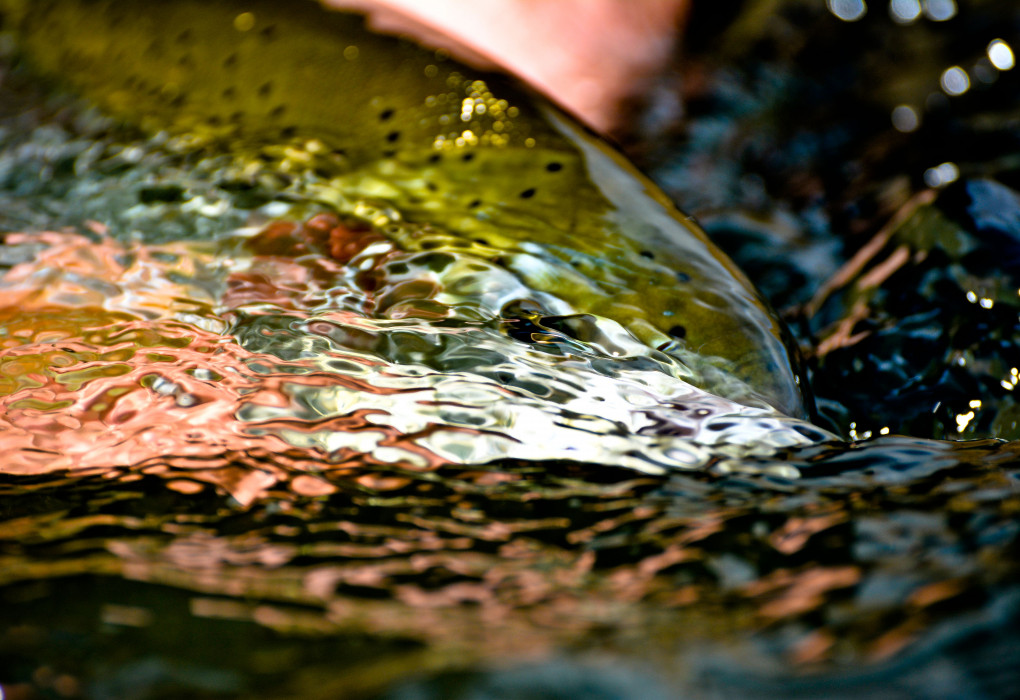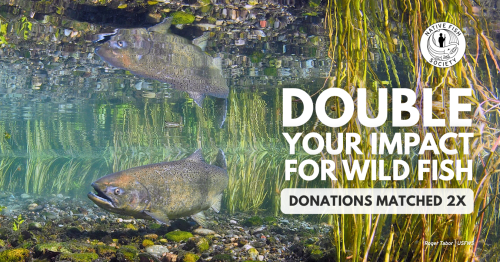The Future of Steelhead in Puget Sound
This is our response to the WDFW led QuickSilver portfolio report, a plan presented to enable the recovery of Steelhead in Puget Sound. Please read our detailed concerns with the plan, and please click on the link to the document that outlines our specific reactions to each activity suggested.
In 2017, WDFW took a new approach and started a three-year process with the Puget Sound Steelhead Advisory Group to develop a vision for the future of Washington’s state fish and recreational anglers in Puget Sound rivers. Last year, the Washington State Department of Fish and Wildlife (WDFW) published the QuickSilver Report, a portfolio of recommendations for future Puget Sound Steelhead fisheries.
Breaking with tradition, WDFW gave the advisory group of steelhead anglers the reins to develop their own strategies and recommendations for managing steelhead in the region. The QuickSilver Report is a suite of management suggestions arising from this advisory group.
The QuickSilver Report advocates for creating watershed scale experiments with different fishing opportunities based on the unique conditions in each basin. The goal is to try and test strategies against fishery and conservation objectives—fishing opportunity and recovery of populations, respectively. Once tested, fisheries or hatchery programs that aren’t achieving their objectives or providing benefits for anglers would be adjusted or abandoned.
There are definitely “wins” for wild fish, such as the no hatchery and wild catch-and-release fishery on the Skagit River, arguably the last remaining stronghold of wild steelhead in Puget Sound. But there are other aspects that cannot be considered a “win.” The QuickSilver Report proposes fisheries on threatened fish, increased hatchery production, and new hatcheries including the use of wild fish for hatchery broodstock. Given the precarious state of steelhead in the region, and a deep body of scientific knowledge on the factors limiting conservation and recovery of wild populations, it is inappropriate to be experimenting with risky approaches that could be the death knell for these fish.
Native Fish Society has significant concerns with the QuickSilver plan. As proposed, management under the Quicksilver Portfolio disproportionately increases risk to wild populations in a number of watersheds while focusing on wild fish conservation and recovery in too few rivers. Further, the Quicksilver Portfolio as presented lacks specificity and control. This approach prioritizes one wild run over another with outcomes targeted at recreational angling, not conservation and recovery. Further, there are recommendations throughout the QuickSilver plan that have already been proven to be ineffective at best and harmful at worst for the recovery of wild Steelhead. Results published in papers, some by WDFW’s own scientists, clearly outline the ineffectiveness of segregated and integrated steelhead hatchery broodstock, as an example. Yet, both of these approaches are suggested in the QuickSilver Report.
Make no mistake, Puget Sound Steelhead are struggling. Runs range from functionally extinct, to reasonably healthy—they were listed as “Threatened” under the Endangered Species Act in 2007. The future is also uncertain; degraded habitat, sprawling development, and climate change won’t make recovery any more certain or easy. Given the current state of the steelhead and watersheds of Puget Sound, it is critical that we take a precautionary, science-based approach to steelhead management focused on the conservation and recovery of wild populations. This and meeting tribal treaty rights and needs should be the guiding principle for fisheries management across the region, not just the focus on a few populations and rivers here and there.
Wild Fish Conservancy wrote a “minority report” raising legitimate concerns about the risks to steelhead populations and expressing distrust for WDFW follow-through. It’s our job to keep showing up and advocating for precautionary, science-based management of Puget Sound Steelhead populations.
At the time of writing this letter, WDFW has acknowledged the plight of our coastal Steelhead runs and put into place unpopular but necessary measures to reduce recreational fishing pressure. We commend the department for publicly recognizing the critical state of these fish and acting in their best interest. It’s time we do the same for steelhead populations in Puget Sound.
There are three main strategies suggested in the QuickSilver portfolio approach. We want to address these sections and specify where we align and where we do not. For comments on specific management actions proposed by the QuickSilver Report, please see the document at the end of this article.
- Wild Steelhead Catch and Release Fishery:
- With strong and well-tracked conservation metrics, we would support catch and release fishing opportunities, as long as there is adequate science and ongoing monitoring indicating that a population can sustain catch and release impacts. Such a determination should include consideration of the lethal and sublethal impact of catch and release fishing practices and methods on fish.
- If the best available science is used to create conservation metrics, and WDFW guarantees adequate and consistent monitoring of these metrics, as well as adequate enforcement on these fisheries, NFS would support catch and release fisheries around the region including on the Skagit, Samish, Nisqually, Skokomish, and Elwha rivers.
- As suggested above, beyond what’s proposed in the QuickSilver Portfolio, NFS would support wild fish harvest on populations where it would be biologically defensible and sustainably structured. If WDFW feels wild broodstock collection for hatchery programs is biologically sustainable, then NFS proposes that such catch instead be allocated to wild harvest. Wild harvest should only occur where the best available science strongly suggests that such harvest would not have a negative impact on the sustainability or recovery of a population. Such a management regime would require robust monitoring and enforcement and be tied to scientifically established conservation metrics. Such programs may require a limited-take structure similar to those utilized for controlled hunts of big game species.
- NFS believes that recovering and delisting wild populations should be the management goal for Puget Sound steelhead and that obtaining such a goal should enable well-managed, consumptive fisheries on wild fish populations.
- Any recreational fishery, catch and release or harvest, must include population monitoring, catch reporting, and well-defined management plans that include adaptive management triggers that can result in timely (in-season if needed) changes to the fishery if data indicates that the fishery is a threat to the sustainability and/or recovery of the population. Management plans and monitoring/reporting data should be published for public review.
- With strong and well-tracked conservation metrics, we would support catch and release fishing opportunities, as long as there is adequate science and ongoing monitoring indicating that a population can sustain catch and release impacts. Such a determination should include consideration of the lethal and sublethal impact of catch and release fishing practices and methods on fish.
- Wild Steelhead Broodstock Hatcheries:
- The best available science does not support the use of wild broodstock as a lasting recovery strategy. Indeed, it is troubling that broodstock programs continue with no published results as to their efficacy as a conservation tool while decades of peer-reviewed research clearly demonstrates the multitude of harms that hatcheries inflict on wild fish populations. The collection of wild fish for hatchery broodstock compounds the harm to wild populations by mining individuals out of rivers and removing the opportunity for their progeny to rear in the wild. For these reasons, NFS does not support the use of wild fish as broodstock for non-tribal hatchery programs as proposed in the QuickSilver Report.
- NFS opposes the use of wild fish as broodstock as proposed by the QuickSilver Portfolio and other programs around the region. In particular, we oppose the broodstock hatchery programs on the Nooksack, Cedar, and Skokomish Rivers as proposed by the Quicksilver Portfolio.
- Quicksilver also points out “a number of rivers where habitat is relatively good, but the steelhead run is depleted.” NFS maintains, where good habitat exists, WDFW should not experiment with broodstock hatcheries, which as of yet remain unproven as a long-term conservation tool. Instead, these are the exact watersheds where we should be investing in wild fish revival, as resilient, diverse wild populations have the best chance of success in the face of a changing climate.
- Steelhead Harvest Hatcheries:
- The recommendation that new or expanded “harvest” or segregated hatcheries be added is very troubling as these hatcheries are proven to be a major impediment to recovering wild fish, which is well-documented in science.
- NFS fully supports Tribal treaty rights and harvest needs; WDFW needs to meet its commitments to Tribes as co-managers. WDFW must ensure that its hatchery programs are utilizing the best available science to reduce the impacts to wild fish. For existing hatcheries, NFS supports adding sunset dates to programs that do not serve tribal needs and treaty obligations or are, at present, failing. NFS also strongly encourages WDFW to focus on recovering wild populations that can meet tribal harvest needs in the future.
- As an alternative to these programs and interim measures, NFS supports utilizing existing hatchery infrastructure for land-locked aquaculture production for tribal and non-tribal harvest until wild populations are recovered and can biologically sustain well-monitored harvest fisheries.
We are asking WDFW to take the following steps as this work moves forward:
- Prioritize recovery and delisting of wild steelhead populations.
- Utilize the best available science to guide decisions about the utilization of hatchery Steelhead in waters where wild Steelhead are struggling to recover and thrive.
- Act on the need for better monitoring to inform decision making & provide the necessary funding to undertake the work.
- Publish a work plan, with milestones, timelines, and evaluation metrics, that details a critical review of existing hatcheries that are impacting threatened and endangered fish populations. Upon that review, set sunset dates on hatcheries that are negatively impacting these fish populations.
- Where WDFW cites lack of funding for certain efforts (monitoring, improving fish passage, etc) involve conservation group volunteers. We come highly skilled and willing to follow protocols that follow the best available science and techniques.
Wild Steelhead are resilient when we allow them to be. We want to support a precautionary approach based on the best available science that will ultimately lead to healthy wild steelhead populations and sustainable tribal, recreational, and consumptive fisheries around Puget Sound.

